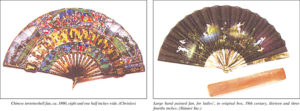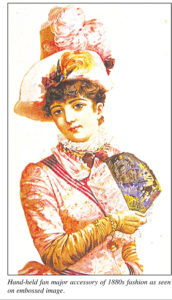 By R. Reed
By R. Reed
Once the elegant hand-held fan was as artful as it was fashionable. It was a nod to style and a ‘cool’ wave to elegance.
For a long time now the fancy fan of the past has been treasured as an heirloom of grander eras.
“Here is where collectors go wild,” noted antiques historian Ann Cole nearly half a century ago, “and I don’t blame them. The antique fan, at its best, is a work of art comparable to a fine painting.”
One might say that the usage of the fashionable fan sort of ‘fanned’ out from various parts of the world. Some accounts suggest the idea of such elaborate fans developed in China and was exported eventually to Europe.
Most sources agree however that the so-called flourishing fan certainly was flourishing in places like England and France during the latter 1500s. Such fans were lavish affairs decked with ostrich or peacock feathers and completed with jeweled handles of rare wood or precious metal.
In England “every man of importance possessed at least two fans,” according to G. Bernard Hughes author of The Antique Collector’s Pocket Book, “one for walking, the other for full dress.”
As a striking scene that might have been, it is known that the rather flashy flourishing fan was more or less replaced in the early 1600s with the folding fan. Such fans, which some say originated in Japan, may have been somewhat smaller but were no less decorative than earlier styles. Such folding fans lent themselves to delicate patterns and the intricate use of ivory and pearl. Moreover artists could use their talents to depict a whole range of scenes and figures.
 In places like London and Paris the painting of pastoral scenes on four to six inch folding fans was a fully established craft by the end of the 17th century. By the early 1700s both men and women were proud to strut their very fashionable and artistic fans everywhere they went.
In places like London and Paris the painting of pastoral scenes on four to six inch folding fans was a fully established craft by the end of the 17th century. By the early 1700s both men and women were proud to strut their very fashionable and artistic fans everywhere they went. Early in the 18th century the size of the decorated folding fan was somewhat more ambitious extending to eight or nine inches, nearly double the size of previous works.
At that point some fashionable fans were decorated with richly colored varnish to imitate lacquer. However most of them, even in the best circles of dress, tended to be “pale and fragile” according to one writer much in the mood of the neo-classical style which was sweeping the wealthy class.
Stylish fans were also making an impression in Colonial America by the 1730s. Not only were they imported from Europe, but they were crafted as well in cities such as Boston and Philadelphia. Plain wisps of wood were used for sticks to enhance the fan’s folding. Even the sticks themselves could be delicate and complex. Some sticks too were imported, however wooden examples were readily made in the Colonies and then handpainted by various craftsmen.
 Not surprisingly the painting of fans became a significant business within itself in America and in Europe during the 18th century. Not only were traditional scenes available, but artists could also do established landmarks and familiar views. Once the scenes were added, the artist then completed the effort with striking surrounding borders. During the 1770s and 1780s newspapers in America carried advertisements for “painting on silk and fan painting” or “coats of arms and fans painted” in various parts of New England.
Not surprisingly the painting of fans became a significant business within itself in America and in Europe during the 18th century. Not only were traditional scenes available, but artists could also do established landmarks and familiar views. Once the scenes were added, the artist then completed the effort with striking surrounding borders. During the 1770s and 1780s newspapers in America carried advertisements for “painting on silk and fan painting” or “coats of arms and fans painted” in various parts of New England. By the latter part of the 18th century there were a number of established fashionable fans in use. The cabriolet fan directly related to the two-wheeled carriage of the same name and not infrequently featured such a vehicle in its design. The medallion fan involved the detailed use of small medallions painted or woven into the fabric of the fan. Also popular was the mourning fan, typically in grim shades of black and gray but still stylish.
There was also the brise fan which included at least a dozen lavishly decorated blades and often incorporated the use of ivory or tortoise shell, gold gilding, and colored ribbons. While other fan styles came and went, the traditionally shelled brise fan remained an eye-catching accessory well into the 19th century.
Antique book author Hughes also mentions the quizzing fan which became a trendy item for the upper class. Basically the quizzing fan offered peep-holes which were simply covered with a transparent textile for discrete ‘lady like’ viewing. Later the cloth film was gradually replaced with a type of glass.
“Behind these quizzing fans the owner could present a modest pose,” according to Hughes, “yet miss nothing of the risque play of the period.”
Fashionable fans of the early 19th century varied somewhat in size, but generally trended upward in size until they stretched to around 12 inches in length. This progress made them larger by far than in previous times.
The brise fan, with its decorative shells remained popular in the early decades of that century. Some were etched with animals or other figures. Others included leaves attached to ivory sticks and filled out with dashes of lace.
By the middle of the 19th century, in addition to the fashionable and fancy ivory-types, fans with lithographed scenes also grew in popularity. One of their first introductions to the public came with the America’s Centennial celebration of 1876 in Philadelphia. The expansive Centennial Exposition featured all manner of fans with lithographed scenes. Some were sold to visitors at the Exposition, while others were handled out simply as promotional items.
When the 1890s arrived, the country was being cooled everywhere with colorful fans bearing lithographed scenes. In New York City, for example, customers flocked to the better sidewalk cafes and restaurants where they were being handed out. Typically the fans depicted views of New York itself with perhaps just a slight mention of the particular establishment itself.
Meanwhile, at the other extreme, young ladies of the 1890s sometimes were bold enough to decorate their very own fans. Starting with a base of paper or heavy silk they would paste mementos scrap-book style directly on the expanded leaves. Often the result was a striking accumulation of college pennants, resort hotel letterheads, and other picturesque paper and cloth material.
As Americans and others entered the 20th century fashionable fans became fewer and fewer and more and more people were attracted to advertising fans which were bold enough to be emblazoned with messages. “Meet me at the Fountain,” offered one brash company, “The Coolest Spot in New York.”
Today, of course, all fans of the past are both ‘cool’ and collectible, with fine examples of 18th century artists and craftsmen being the highest regarded.















Follow Us